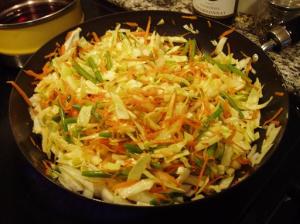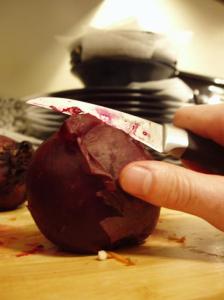This afternoon, being finished with the week’s classes (though, of course, not the week’s schoolwork), I rocked out to blues guitar and made borshch. At least, my version of borshch. I have been sort of hoping that my boyfriend’s mom, an authentic Russian mother, will come and visit and show me whatever the “family recipe” is. However, she wasn’t around and I wanted my soup – it’s rainy and soup is definitely in order, so I forged ahead on my own.
 First, there was chopping of cabbage.
First, there was chopping of cabbage.
About half of a cabbage, sliced thinly, and then the resulting shreds cut up a bit, so that over all there were many little pieces. It looks like a lot in the bowl, but it will get cooked a little before it goes into the soup, and will decrease in size.
To the cabbage, I added one shredded carrot. I was going to do more carrot, but once it was shredded it seemed like a lot. Next I diced up half a large onion, and broke up a big handful of green beans. All these went in the bowl, as storage before they went in a big frying pan.

Mmmm… veggies!

Once I had the veggies squared away, I also diced up four medium potatoes – two Yukon gold, and two red. You can see how differently colored they are, inside and out! I’m not sure that my palate is sophisticated to describe the differences in their tastes, though.

Before I started chopping anything, I had three beets cooking in almost boiling water. They take a while to cook, so it is good to get them started early. By the time I had the veggies frying, they were soft enough to stick a fork in, so I moved them to the cutting board to cool off. I saved the water they cooked in to add to the broth.

While the veggies were frying up…

I was peeling beets…

…and grating them…

…and getting very pink.
It washes off pretty well, but you might want to wear gloves. And don’t expect it to come easily out of a wooden cutting board. This is a powerful color. If you’ve never eaten beets before, the color does go all the way through you. My mother is not a lover of beets, so I never ate them as a child. At some point in college I cooked some for myself, and in true collegiate fashion, ate little else for a day or two. Then my pee was pink, and I thought it was blood and I was dying of some horrible disease. But no, it was just from the beets. No worries!

By the time the beets were all shredded, the veggies, were pretty well cooked, so I put them back in the bowl to cohabit with the beets, and put the potatoes in to fry.

I had some trouble with the potatoes, which probably had to do with not using a non-stick frying pan — they stuck like crazy. Every time I would leave them alone for two minutes, they would affix to the bottom. By the time they were cooked up, there was a layer of potato on the bottom of the pan that I had to leave to soak off later.

Finally, we’re ready to actually put everything together as soup! First, we have the water that the beets were in. It is super ruby red, and very pretty. I added the potatoes first, since they maybe needed some cooking still. Then, my secret ingredients!

That’s right — veggie broth. Organic and on sale at the store recently. Some tomato paste because last winter when I made borshch I didn’t realize it was supposed to include tomato anything, and my boyfriend explained that I did it all wrong. And some black-eyed peas, because I vaguely recall some beans in the borshch that his mother made, except I think they may have been cannelloni, which I didn’t find at the store.
 Secret ingredient #4 is the squish inside bits of a squash I baked the other day. I took out most of the seeds and fried them, and I was going to put the stringy bits in the compost, but then I wondered why I’ve never eaten that part of the squash — I don’t think there’s anything wrong with it… so I saved it, and now it’s soup. I did cut it up some, because it was originally one big fibrous mass.
Secret ingredient #4 is the squish inside bits of a squash I baked the other day. I took out most of the seeds and fried them, and I was going to put the stringy bits in the compost, but then I wondered why I’ve never eaten that part of the squash — I don’t think there’s anything wrong with it… so I saved it, and now it’s soup. I did cut it up some, because it was originally one big fibrous mass.
So here’s everything in the pot!

I let it simmer for a while, mixed everything in pretty well. There was salt in the vegetable broth, and the borshch tasted pretty good as it was, so I didn’t add any spices. Just a little salt once I got it in my bowl.
And here’s the final product! Red red red Soviet soup! Yum!

This reminds me of something I learned in high school — a somewhat non- sensical reasoning for why fire engines are red.
1. Fire engines have ladders.
2. A ladder has 12 rungs.
3. There are 12 inches on a ruler.
4. Queen Mary was a ruler.
5. Queen Mary is also a ship.
6. Ships sail on the ocean.
7. Fish live in the ocean.
8. Fish have fins.
9. The Finns fought the Russians.
10. The Russians were Communists.
11. Communists wear red.
Ergo…














